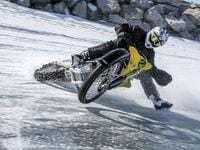An airplane is controllable around three axes that intersect at the plane’s center of gravity. The plane banks around the roll axis, climbs and dives around the pitch axis, and turns left and right around the yaw axis. In fact, any object when it freely rotates will do so around an axis intersecting its center of gravity.
A professional pilot (and motorcyclist) recently emailed this magazine to note that, while both airplanes and motorcycles roll, pitch, and yaw, a motorcycle is obviously less free to move around its three axes. He knew how it worked with airplanes. How does it work with bikes?
Let’s take roll first. Our pilot friend suggested that a motorcycle rolls around its tire contact patches (actually, around a point that’s the radial center of the tires’ curved surface). But does it? Certainly at rest that’s the case, but once moving, this changes. To initiate a left turn, we have to get the motorcycle to roll—or lean—to the left. To do that, we countersteer to the right. The countersteering causes the tire contact patches to move to the right, out from under the center of gravity. Without support directly under the CG, the bike begins to fall (or roll or lean) to the left, and the left turn begins.
The motorcycle is in fact rolling around its center of gravity much as an airplane does. This is true roll, with the tires, not the CG, moving to the left and right to create roll. The CG of most motorcycles is typically just under the seat, near the top of the engine, and so the feeling for the rider is that his butt is almost stationary in roll, with the upper body rolling one way and the legs the other. Remember here that the CG includes the rider, and as the rider moves around the CG changes. Leaning to the inside in a turn, or hanging off, shifts the CG to the inside and requires the bike itself to roll (lean) less in a given turn.
The rider controls roll with countersteering and with body position. What about pitch? Pitch is only secondarily controlled by the rider, as it’s a byproduct of braking and acceleration. Since a motorcycle’s center of gravity is relatively high and its wheelbase short (compared to a car’s, for instance), acceleration and braking can sometimes rotate the machine enough to lift the front or rear wheel.
An aerobatic airplane can see basically unlimited pitch angles, but with motorcycles, true pitch around the CG is very limited. Under acceleration or braking there is an initial rotation around the CG that’s dealt with through the suspension, but once a wheel leaves the ground in a wheelie or a stoppie, the bike starts to pivot around the axle of the wheel that remains on the ground rather than around the CG.
As with pitch, a motorcycle’s yaw motion is limited but is somewhat more interesting than pitch because it’s not just a function of acceleration/deceleration forces. Yaw angles during road riding and even racing are usually small, but get the rear tire sliding and the apparent yaw angles can get dramatically large.
But sliding yaw is not true yaw, with the bike pivoting around the CG. We’ve all seen sliding in flat track, roadracing, and now, drifting—this is sliding yaw on display. Because the front tire in these situations (usually) has more traction relative to the sliding rear and continues tracking, the bike pivots around the steering head as the rear tire slides to one side. Again, as in pitch, the bike is attempting to pivot in yaw around the CG, but in this yaw the bike is built so that the effective pivot is the steering axis, and the CG is moving left or right behind the steering axis.
In roll, pitch, and yaw a bike wants to do what an airplane does and rotate around its three CG-intersecting axes. In each case there are limits and restraints that aren’t present in planes, but the effects are plenty interesting and spectacular nonetheless.












/cloudfront-us-east-1.images.arcpublishing.com/octane/S35YGSEMEZB4BLTDJTSZPF4GLA.jpg)
/cloudfront-us-east-1.images.arcpublishing.com/octane/5UOT6HPX2JFMRJAX6EH45AR4MQ.jpg)
/cloudfront-us-east-1.images.arcpublishing.com/octane/OKWOJWAKP5EP3OACCRRWPCIX2Q.jpg)
/cloudfront-us-east-1.images.arcpublishing.com/octane/2WF3SCE3NFBQXLDNJM7KMXA45E.jpg)
/cloudfront-us-east-1.images.arcpublishing.com/octane/G4MG6OUCJNBSHIS2MVVOTPX65E.jpg)
/cloudfront-us-east-1.images.arcpublishing.com/octane/IIGGWFOTOJGB7DB6DGBXCCMTDY.jpg)
/cloudfront-us-east-1.images.arcpublishing.com/octane/QSTCM6AVEZA5JJBUXNIQ3DSOF4.jpg)
/cloudfront-us-east-1.images.arcpublishing.com/octane/U4I7G625B5DMLF2DVIJDFZVV6M.jpg)
/cloudfront-us-east-1.images.arcpublishing.com/octane/B6XD6LS6IVCQPIU6HXDJSM3FHY.jpg)
/cloudfront-us-east-1.images.arcpublishing.com/octane/ICL63FEDDRDTTMINYICCEYGMDA.jpg)
/cloudfront-us-east-1.images.arcpublishing.com/octane/FCGZHQXRBZFLBAPC5SDIQLVF4I.jpg)
/cloudfront-us-east-1.images.arcpublishing.com/octane/WNOB6LDOIFFHJKPSVIWDYUGOPM.jpg)

/cloudfront-us-east-1.images.arcpublishing.com/octane/X33NU3E525ECRHXLNUJN2FTRKI.jpg)
/cloudfront-us-east-1.images.arcpublishing.com/octane/6KKT5NNL2JAVBOXMZYS5ZO76YA.jpg)
/cloudfront-us-east-1.images.arcpublishing.com/octane/J5RKG5O455GMPGQRF2OG6LRT7A.jpg)
/cloudfront-us-east-1.images.arcpublishing.com/octane/GX2CIZKQVRH2TATDM26KFG2DAE.jpg)
/cloudfront-us-east-1.images.arcpublishing.com/octane/ZWIDYSAKQZHD5BHREMQILXJCGM.jpg)
/cloudfront-us-east-1.images.arcpublishing.com/octane/CYUHJZCTSJCH3MRAQEIKXK7SCQ.jpg)
/cloudfront-us-east-1.images.arcpublishing.com/octane/LKOFINY56FCXJCANJ5M7ZDQUBY.jpg)
/cloudfront-us-east-1.images.arcpublishing.com/octane/4NBPDACMWJH63JQYJVK3QRBDZI.jpg)
/cloudfront-us-east-1.images.arcpublishing.com/octane/KKHQHRR3FJGX7H2IPU6RALMWG4.jpg)

/cloudfront-us-east-1.images.arcpublishing.com/octane/5IOFS5JAE5FOXMNA23ZRAVVYUU.jpg)